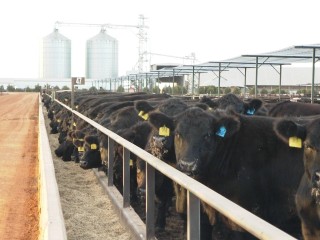 Higher retention rates of cattle in feedlots as processors reduced weekly kills, and resilient domestic beef demand have been offered as explanations for a surprising two percent rise in cattle numbers on feed in the latest quarterly feedlot industry survey released this morning.
Higher retention rates of cattle in feedlots as processors reduced weekly kills, and resilient domestic beef demand have been offered as explanations for a surprising two percent rise in cattle numbers on feed in the latest quarterly feedlot industry survey released this morning.
The June quarter feedlot industry survey indicates a slight increase in cattle on feed over the March quarter, and similar figures as those seen this time last year. Total numbers on feed across Australia reached 792,446 head at the end of June.
Numbers on feed in Queensland rose 10,000 head over the quarter to 438,777 head, while NSW, the second largest lotfeeding state, was virtually unchanged at 250,716. Victorian lotfeeders showed the largest relative increase, rising from 51,700 to 61,700 during the course of the three-month cycle.
Australian Lot Feeders Association president Jim Cudmore said the increase in Queensland reflected higher retention rates of cattle as processors reduced weekly kills of grainfed cattle in the wake of subdued demand in particularly Japan and Korea.
In the south, more competitive grain prices towards the end of the quarter and resilient domestic beef demand encouraged lotfeeders to increase cattle numbers, he said.
In WA, which suffered a sizeable decline in feeding activity from around 23,000 to 15,000 head, continued poor seasonal conditions and high ration prices had accounted for that state’s reduction.
“Increased cattle turnoff over the quarter reflected lotfeeders’ transition from longer fed export cattle to quicker turnover domestic and yearling cattle in Victoria, Queensland and NSW,” Mr Cudmore said.
That trend was well illustrated in Queensland, where there were 381,500 grainfed cattle turned off for the June quarter, up from 287,129 head for the same period last year – a 25pc difference.
Mr Cudmore said the June result indicated the ongoing importance and resilience of the grainfed sector during what continued to be very difficult trading conditions.
“Year-on-year increases in both feeder cattle and grain prices in conjunction with a strong A$ (averaging US108¢ over the quarter) thwarted any chance for improvement in lotfeeding margins.”
Feeder cattle averaged 16pc higher than this time last year, as good seasonal conditions maintained the strong restocker demand for young cattle throughout the quarter.
Feedgrain prices were higher across all categories in the June quarter, with sorghum and wheat averaging 19pc and 16pc higher year-on-year in the Darling Downs, while feed barley and wheat from the Riverina averaged 23pc and 19pc higher over the same period.
Meat & Livestock Australia’s market information and analysis manager, Tim McRae, said that despite the strong A$, grainfed beef exports totalled 53,431 tonnes in the June quarter, a rise of 8pc year-on-year and 5pc on the previous quarter.
Grainfed beef exports in Australia’s main markets, Japan and Korea were up year-on-year 5pc and 19pc respectively, although US exports to the same destinations in comparison increased 50pc and 44pc over the same period.
“Unfortunately, the increase in exports also reflected lower prices, with indicative chilled beef returns for Australian beef exports to Japan declining 8 to 19pc in A$ terms since April,” Mr McRae said.
Some analysts quoted on Beef Central earlier suggested that the June 30 timing of the survey would perhaps miss capturing the current market sentiment, with big declines in feeding profitability evident throughout the month of July.
“If the survey was taken another month later, I think we would have seen a very different result,” one senior industry stakeholder said.



HAVE YOUR SAY